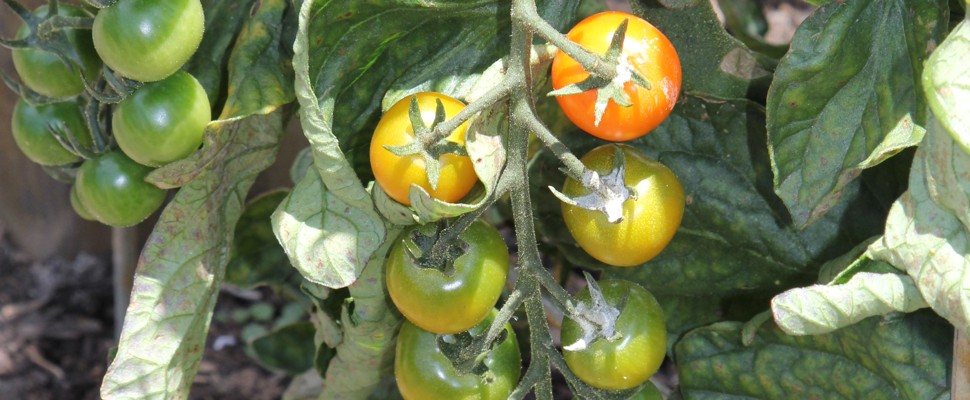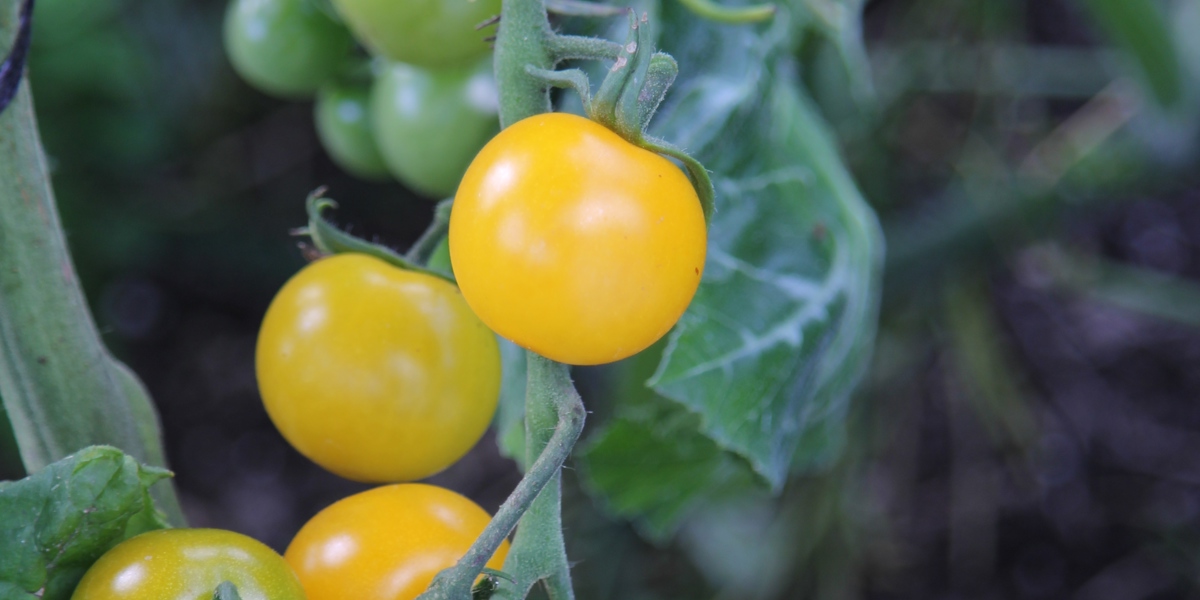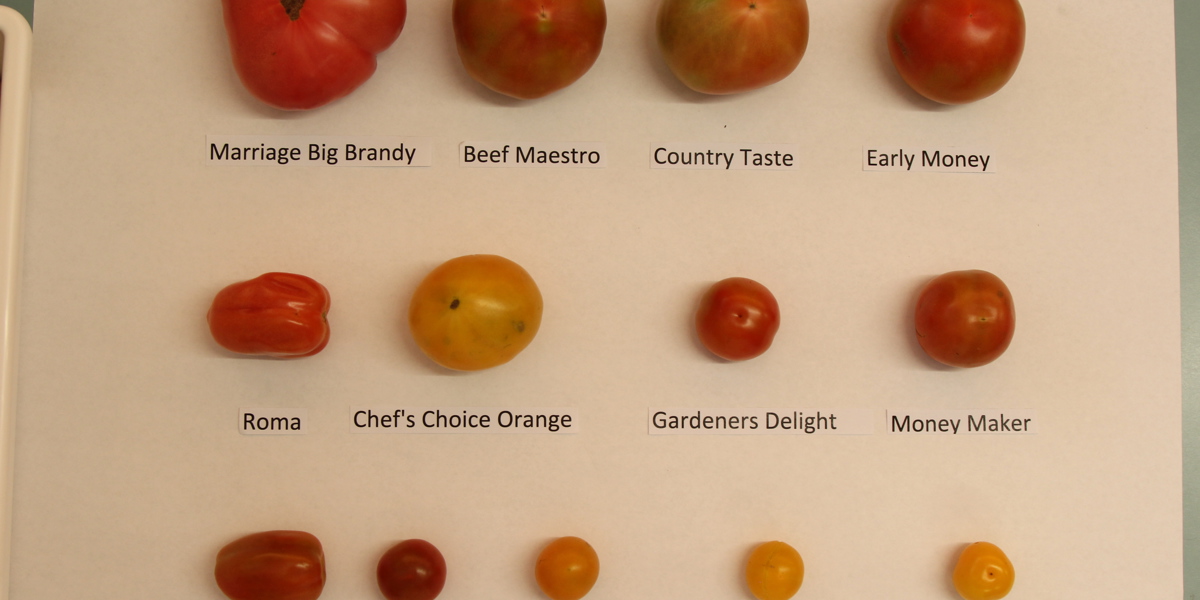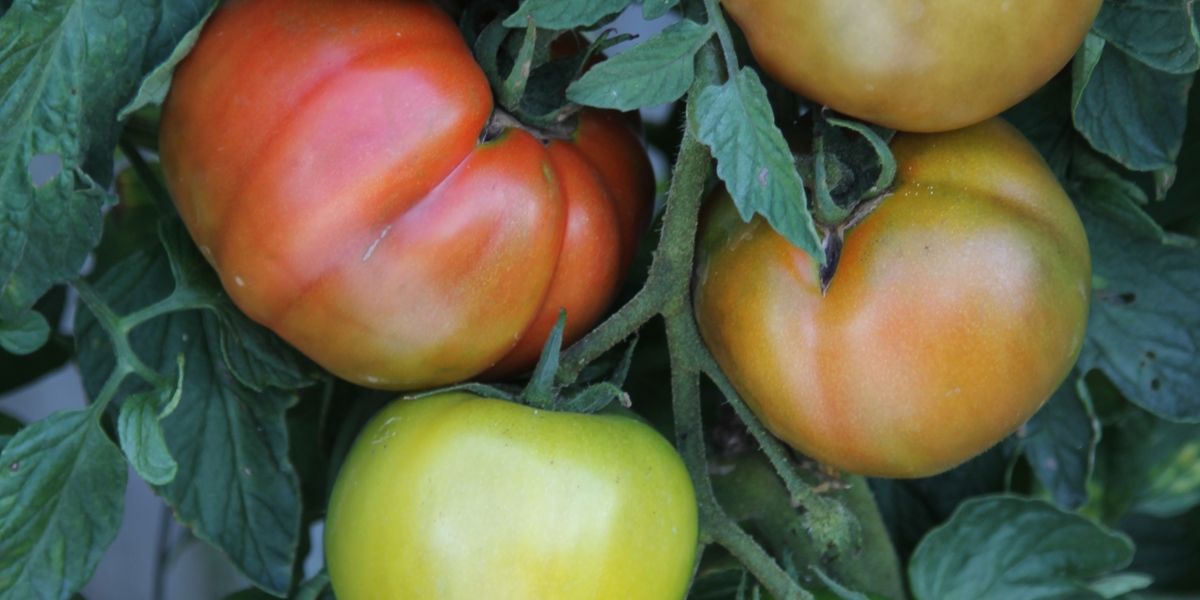
Which tomato cultivars grow well in Auckland?
Summer tomato trial 2016-2017
NB: since this trial was published many cultivars are no longer available. Gardener's Delight and Chef's Choice Orange are available from Kings Seeds (as of July 2020).
Introduction
Tomatoes (Solanum lycopersicum) originating from South and Central America are a popular plant for growing by the home gardener. Tomatoes are a perennial in their native habitat but are grown as an
Copper sprays can be applied as a preventative fungicide against blight but it is important to know if they are cost effective in terms of what is lost if they are not used, against the benefits if they are used. Tomatoes are gross feeders, so it is important to know what benefits can be gained from regular foliar feeds, or if only an initial fertiliser application is sufficient.
Auckland Botanic Gardens (ABG) aims to minimize agrichemical use, so it was necessary to gauge what applications are required to ensure a good harvest with as little chemical residue as possible.
The trial consists of F1 hybrid and open pollinated indeterminate varieties of tomatoes. F1 tomato hybrids are the first generation of tomatoes produced from cross-pollinating two different types of tomato together. Results are uniform in the first (F1) generation but seed produced by these plants are either sterile or not true to type. Open pollinated varieties tend to be stabilised meaning the seeds they produce will resemble the parent plants. Indeterminate tomatoes grow as a vine, and continue producing fruit as well as ripening at the same time until frosts kill the plants off. Determinate tomatoes are more compact and do not require staking. Typically they produce fruit over a shorter period than indeterminates.
Aims
The aim of this trial was to identity the top performing cherry, medium, and large tomato varieties suitable for growing in Auckland in terms of vigour, yield, taste, and disease resistance. The trial further sought to determine the benefits of applications of a foliar feed and a preventative fungicide spray on the trialled plants. F1 hybrids and Open pollinated varieties were also compared.
Methods
13 cultivars of commercially available tomatoes were selected for the trial (Table 1). Tomatoes were sown (mid-August 2016), grown on, and planted out (end of October 2016) into the trial garden at the Auckland Botanic Gardens. Three plants of each cultivar were planted in each treatment. However ‘Sweet Gold’ and ‘Gold Nugget’ only had 10 plants grown in total therefore in two treatments there was only two plants of these cultivars. ‘Marriage Big Brandy’ was sown and bagged up at the same time as the other cultivars but was planted one week after the other cultivars. There were a total of 152 plants in the trial. Prior to planting in the trial bed, soil samples were taken for testing for nutrients such as calcium, and sent to Hill Laboratories. The soil test results obtained from Hill Laboratories showed the pH (6.3) was in the medium range (6.0 – 6.5), as were phosphorus (97mg/L), potassium (2.10 me/100g), and sodium (0.26 me/100g). Calcium (25.7 me/100g), Magnesium (6.34 me/100g), Nitrogen (0.68%) and Organic matter (22.3%) were in the high range.
Biofert was applied to the area at a rate of 1 cup (250 ml) per square metre. The plants were planted in rows running north to south, in full sun, although exposed to the prevailing wind. Plants were de-lateralised and clipped onto a trellis for support. They were spaced at 800mm apart, and planted with half the stem below the soil surface and at a 45 degree angle. This encouraged root growth and ensures good support for the plants.
Table 1 Tomato cultivars descriptors including size class and colour
|
Cultivar |
Colour |
Size |
F1/Open Pollinated |
|
S. ‘Gardener's Delight’ |
Red |
Cherry |
Open Pollinated |
|
S. ‘Gold Nugget’ |
Gold |
Cherry |
Open Pollinated |
|
S. ‘Sungold’ |
Gold |
Cherry |
F1 |
|
S. ‘Sweet 100’ |
Red |
Cherry |
F1 |
|
S. ‘Sweet Gold’ |
Gold |
Cherry |
F1 |
|
S. ‘Chef's Choice Orange’ |
Orange |
Medium |
F1 |
|
S. ‘Early Money’ |
Red |
Medium |
F1 |
|
S. ‘Juliet’ |
Red |
Medium |
F1 |
|
S. ‘Money Maker’ |
Red |
Medium |
F1 |
|
S. ‘Roma’ |
Red |
Medium |
Open Pollinated |
|
S. ‘Beef Maestro’ |
Red |
Large |
F1 |
|
S. ‘Country Taste’ |
Red |
Large |
F1 |
|
S. ‘Marriage Big Brandy’ |
Red |
Large |
F1 |
The trial bed was divided into four quadrants and the plants in each received four different treatments (Table 2):
1. Control (no treatments)
2. Copper only
3. Foliar fertiliser only
4. Copper and foliar fertiliser treatment
The products used were AgriSea seaweed base fertiliser, and Yates Liquid Copper. Applications of copper started at the end of December 2016 when blight was first observed. Applications of copper spray continued weekly until mid-March. AgriSea fertiliser was applied fortnightly throughout the trial.
Table 2 Treatments applied to the tomatoes with abbreviated code
|
|
Fungicide |
||
|
Copper |
No Copper |
||
|
Fertiliser |
AgriSea |
CuL |
CL |
|
No AgriSea |
CuNL |
CNL |
|
Plants were monitored weekly for vigour, flower and fruit set, harvestable fruit, pests and diseases. Harvesting was conducted three times per week once fruit showed indications of colour changes. The total weights (kg) and numbers of tomatoes from each treatment for every cultivar were recorded from the start of fruiting until mid-March. Fruit was not harvested after mid-March and a final date of fruiting was recorded. A sample of 25 fruit from every cultivar in all treatments was measured for individual fruit weight (grams) and fruit diameter (mm). Ten ripe fruit from each treatment and cultivar were Brix tested using a refractometer which was calibrated before use with water. Brix testing is a measure of the sugar levels (percentage of sucrose, also referred to as degree brix) in the fruit. Three of these fruit were taste tested and described. A public taste test (n = 35) was conducted with participants asked to rate sweetness, acidity, flavour, appearance and personal preference on a scale of 1 to 10. When the plants reached maturity, all plant heights were measured and averaged. During the trial, three evaluations were conducted to evaluate the overall performance of the plants, focusing on fruiting, habit, vigour, pest and disease issues. Each evaluation gave an overall rating to each cultivar on a scale from 1 (poor performer) to 10 (excellent performer). Plants that score an 8 or higher are recommended for growing in Auckland.
Results
Size, vigour and yield
In terms of plant vigour there was inconsistent and indiscernible differences between plants with liquid fertiliser and no liquid fertiliser. Results from this trial indicted no significant benefits from foliar fertiliser applications.
The amount of blight observed during the season was very low, therefore no discernible differences were noted between plants where copper was applied and where no copper was applied. In another growing season with a higher incidence of blight infection a significant different in the health of sprayed versus non-sprayed plants might occur.
Table 3 shows the time to harvest and harvest period for the different cultivars, as well as individual fruit measurements. There is an approximately 1 month difference between the earliest harvesting, ‘Sweet Gold’ and ‘Gold Nugget’ and latest harvesting cultivars, ‘Beef Maestro’ and ‘Marriage Big Brandy’. This was not unexpected as small fruited tomatoes typically produce fruit earlier than large fruited varieties. Of the five cherry tomatoes, ‘Gardener’s Delight’ had the largest and heaviest individual fruit, and the tallest most vigorous plants. Of the five medium tomatoes, ‘Chef’s Choice Orange’ has the largest and heaviest fruit, while ‘Juliet’ had the tallest, vigorous plants. Of the large cultivars, ‘Marriage Big Brandy’ had the heaviest individual fruit. ‘Gardener’s Delight’ had the longest fruiting period of 22 weeks, followed by ‘Sungold’, ‘Juliet’ and ‘Roma’ (fruiting period of 21 weeks), while ‘Marriage Big Brandy’ had a very short fruiting period of 9 weeks.
Table 3 Time to harvest, harvest period, size and weight of fruit (n = 25), and height of plants at maturity.
|
Tomato cultivars |
Time to harvest (weeks) |
Harvest period (weeks) |
Average individual fruit weight (g) |
Average individual fruit diameter (mm) |
Average height of plant (cm) |
|
S. ‘Gardener’s Delight’ |
21 |
22 |
21.6 |
34.4 |
242 |
|
S. ‘Gold Nugget’ |
19 |
12 |
11.4 |
27.7 |
93 |
|
S. ‘Sungold’ |
20 |
21 |
10.3 |
26.7 |
185 |
|
S. ‘Sweet 100’ |
21 |
19 |
10.7 |
27.3 |
243 |
|
S. ‘Sweet Gold’ |
19 |
19 |
13.6 |
29.4 |
225 |
|
S. ‘Chef's Choice Orange’ |
22 |
19 |
131.0 |
65.4 |
203 |
|
S. ‘Early Money’ |
22 |
18 |
124.9 |
63.3 |
210 |
|
S. ‘Juliet’ |
20 |
21 |
28.9 |
33.6 |
213 |
|
S. ‘Money Maker’ |
22 |
19 |
59.5 |
48.3 |
173 |
|
S. ‘Roma’ |
21 |
21 |
62.7 |
44.4 |
157 |
|
S. ‘Beef Maestro’ |
23 |
19 |
111.0 |
58.3 |
188 |
|
S. ‘Country Taste’ |
22 |
19 |
158.2 |
68.2 |
220 |
|
S. ‘Marriage Big Brandy’ |
23 |
9 |
168.2 |
74.9 |
210 |
In order to make a fair comparison of overall performance of the tomatoes trialled, each cultivar is only compared to the same size class (cherries, medium and large). There were little or inconsistent differences of total weight for each cherry cultivar between the treatments (Table 4). ‘Sweet 100’ and ‘Sweet Gold’ produced the greatest numbers of tomatoes.
Juliet produced a significantly higher number of fruit compared to the other four medium sized cultivars. However the total weight of these ‘Juliet’ fruits did not outweigh the other cultivars. Because ‘Chef's Choice Orange’ or ‘Early Money’ individual fruit are larger and heavier, the total weight of fruit produced during the harvest period quickly amounts. ‘Juliet’ is a very prolific fruiter.
For the large sized tomatoes, ‘Country Taste’ had the greatest yield of the three cultivars. ‘Beef Maestro’ plants were not particularly vigorous and particularly in the control treatment plants died before the end of the trial which is explains the lower yield in terms of weight and number of fruit. The number of fruit of ‘Marriage Big Brandy’ is recorded higher than we would expect because this cultivar is inconsistent with some plants producing large fruit and others small cherry sized tomatoes. It is unclear if this is representative of the cultivar or due to an error in the nursery process. These small fruits of ‘Marriage Big Brandy’ were excluded from individual measurements, tasting and brix testing. ‘Marriage Big Brandy’ appears to not be a stable F1 yet.
Individual fruit size of each cultivar was not statistically significant between the treatments. This means that the fruit sizes were consistent regardless of fertiliser application or protection from blight. For individual weights comparing only same cultivars with treatments, there was generally no statistically significant difference in weights. However, ‘Country Taste’ (lower weight), ‘Beef Maestro’ (greater weight) and ‘Money Maker’ (greater weight) in the Copper/Liquid fertiliser treatment showed a significant difference compared to cultivars of the other treatments.
Table 4 Total number and weight of fruit, and brix reading for each tomato cultivar in each treatment.
|
Cultivar |
Treatment |
Number of fruit |
Total weight of fruit (kg) |
Brix level (% sucrose in fruit) |
|
S. ‘Gardener’s Delight’ |
CL |
251 |
6255 |
4.16 |
|
CNL |
264 |
6700 |
4.2 |
|
|
CuL |
328 |
8020 |
4.32 |
|
|
CuNL |
292 |
7130 |
4.77 |
|
|
S. ‘Gold Nugget’
|
CL |
455 |
4040 |
3.4 |
|
CNL |
316 |
2910 |
3.96 |
|
|
CuL |
337 |
2815 |
3.44 |
|
|
CuNL |
460 |
3125 |
3.56 |
|
|
S. ‘Sungold’
|
CL |
246 |
2685 |
4.75 |
|
CNL |
269 |
3295 |
4.9 |
|
|
CuL |
416 |
3370 |
5.25 |
|
|
CuNL |
452 |
3810 |
4.97 |
|
|
S. ‘Sweet 100’
|
CL |
774 |
7240 |
5.29 |
|
CNL |
571 |
4610 |
4.62 |
|
|
CuL |
564 |
5345 |
5.44 |
|
|
CuNL |
509 |
4525 |
5.6 |
|
|
S. ‘Sweet Gold’
|
CL |
699 |
6810 |
4.6 |
|
CNL |
558 |
3565 |
4.35 |
|
|
CuL |
567 |
4965 |
3.55 |
|
|
CuNL |
547 |
4610 |
4.93 |
|
|
S. ‘Chef's Choice Orange’
|
CL |
120 |
16780 |
3.41 |
|
CNL |
69 |
9030 |
3.76 |
|
|
CuL |
73 |
11635 |
3.76 |
|
|
CuNL |
107 |
17400 |
3.68 |
|
|
S. ‘Early Money’
|
CL |
130 |
16190 |
4.15 |
|
CNL |
144 |
18590 |
4.51 |
|
|
CuL |
154 |
39210 |
4.34 |
|
|
CuNL |
134 |
17390 |
4.47 |
|
|
S. ‘Juliet’
|
CL |
361 |
9440 |
4.76 |
|
CNL |
306 |
7740 |
4.66 |
|
|
CuL |
368 |
8745 |
4.3 |
|
|
CuNL |
297 |
8870 |
4.68 |
|
|
S. ‘Money Maker’
|
CL |
165 |
9095 |
3.28 |
|
CNL |
115 |
7335 |
3.44 |
|
|
CuL |
107 |
7865 |
3.32 |
|
|
CuNL |
89 |
4965 |
3.49 |
|
|
S. ‘Roma’
|
CL |
124 |
8420 |
4.04 |
|
CNL |
123 |
5080 |
3.36 |
|
|
CuL |
140 |
5265 |
3.87 |
|
|
CuNL |
129 |
5310 |
3.52 |
|
|
S. ‘Beef Maestro’ |
CL |
32 |
3405 |
4.14 |
|
CNL |
36 |
3735 |
4.02 |
|
|
CuL |
52 |
7210 |
3.64 |
|
|
CuNL |
45 |
6085 |
3.57 |
|
|
S. ‘Country Taste’ |
CL |
83 |
12870 |
4.02 |
|
CNL |
100 |
11140 |
4.3 |
|
|
CuL |
194 |
12580 |
3.74 |
|
|
CuNL |
116 |
14595 |
4.16 |
|
|
S. ‘Marriage Big Brandy’ |
CL |
127 |
14620 |
3.63 |
|
CNL |
216 |
8060 |
3.34 |
|
|
CuL |
171 |
9325 |
3.16 |
|
|
CuNL |
207 |
4425 |
3.58 |
Pest and disease
Only one cultivar had blight observed during the trial from mid to late December, this was on one plant of ‘Money Maker’. One third of the plant was affected by blight. Some mildew was observed on the stems of ‘Beef Maestro’, ‘Sweet 100’ and ‘Marriage Big Brandy’ towards the end of the harvest period. Plants were not covered by bird netting therefore there was some evidence of birds damage to fruit. The occasional fruit had blossom end rot, but was not of significant or on one particular cultivar.
Brix testing and tasting
When comparing brix levels of fruit from the same cultivars (Table 4), most tomato cultivars showed no statistically significant difference between the four treatments. ‘Sweet 100’ fruit from the control group with no copper or liquid fertiliser had a significantly lower level of sugar compared to the other three treatments. ‘Roma’ from the two liquid fertiliser treatments had significantly high sugar levels than the treatments with no liquid fertiliser. ‘Chef’s Choice Orange’ liquid fertiliser and no copper had a significantly lower level of sugar compared to the other three treatments. ‘Sweet Gold’ copper and liquid fertiliser treatment had significantly lower level of sugar compared to the other three treatments. ‘Gold Nugget’ fruit from the control group with no copper or liquid fertiliser had a significantly higher level of sugar compared to the other three treatments. ‘Sweet 100’ had the highest sugar levels of the cherry tomatoes (Brix range 4.6 – 5.6). ‘Juliet’ had the highest sugar levels of the medium tomatoes (Brix range 4.3 – 4.76). ‘Country Taste’ had the highest sugar levels of the large tomatoes (Brix range 3.74 – 4.16).
A small sample (n = 3) of each cultivar in each treatment was taste tested and it was difficult to taste differences in flavour. It is unlikely that the treatments would affect the flavour and taste of the fruit. The public taste testing showed very variable results with no consistent vote for a preference. The testing helped engage people with plants and showed they were very interested in the trial. The public tasting agreed that ‘Sweet 100’ was the sweetest cherry tomato however the others did not align with the Brix testing results.
From the evaluations conducted and the data gathered on the plants, we recommend ‘Gardener’s Delight’ (cherry), ‘Sweet 100’ (cherry) ‘Juliet’ (medium), ‘Chef’s Choice Orange’ (medium) and ‘Early Money’ (medium) as star performers (Table 5). Of the large cultivars, ‘Country Taste’ was rated a 7, this tomato did well however not as well as the others that rated an 8 but was the best of the larger fruited tomatoes. There might be better large tomatoes in the market to trial in the future.
Table 5 Overall rating of plant performance considering yield, plant vigour, and pest and disease issues. Asterisk (*) shows those that are regarded as star performers.
|
Cultivar |
Overall rating |
|
S. ‘Gardener’s Delight’ |
8* |
|
S. ‘Gold Nugget’ |
3 |
|
S. ‘Sungold’ |
7 |
|
S. ‘Sweet 100’ |
8* |
|
S. ‘Sweet Gold’ |
5 |
|
S. ‘Chef's Choice Orange’ |
8* |
|
S. ‘Early Money’ |
8* |
|
S. ‘Juliet’ |
8* |
|
S. ‘Money Maker’ |
6 |
|
S. ‘Roma’ |
4 |
|
S. ‘Beef Maestro’ |
5 |
|
S. ‘Country Taste’ |
7 |
|
S. ‘Marriage Big Brandy’ |
4 |
Conclusions
Of the cherry tomatoes, ‘Gardener's Delight’ produced the best yields by weight, followed by ‘Sweet 100’. ‘Sweet 100’ had a slightly higher Brix level which indicates higher sugar levels. ‘Gardener's Delight’ and ‘Sweet 100’ are recommended as cherry cultivars to grow in Auckland.
Of the medium tomatoes, ‘Early Money’ produced the highest yield by weight, followed by ‘Chef's Choice Orange’. ‘Juliet’ produced the highest numbers of fruit. Both ‘Early Money’ and ‘Juliet’ had slightly higher Brix levels, indicating higher sugar levels. ‘Early Money’, ‘Chef's Choice Orange’, and ‘Juliet’ can be grown well in the Auckland area.
Of the large tomatoes, ‘Country Taste’ produced the highest yield by weight, followed by ‘Marriage Big Brandy’. ‘Marriage Big Brandy’ had a few plants that produced cherry size tomatoes rather than the expected larger fruit and is not recommended. ‘Country Taste’ could be grown well in the Auckland area but did not perform as well as the smaller fruited recommendations. In general cherry varieties do better overall than other tomatoes.
Liquid fertiliser applications did not produce significant differences between treatment yields or tomato taste. This was an unnecessary expense given the insignificant differences to those plants that just received an initial application of Biofert. We recommend an initial application of a liquid fertiliser but based on the evidence from this trial, regular applications during growing season are not required.
In terms of blight resistance, blight did not have a major impact during this tomato season (summer 2016 – 2017) and was uncommon on the trial plants. Copper spraying started relatively early in the tomato season due to an early sign of blight on one of the plants but no other signs of blight was observed. However, the application of copper could be started later, i.e. January, if blight had not been observed. Summer 2016-2017 was expected to facilitate blight due to the extreme humidity however this was not the case. It was an unusual year and results would probably be different if repeated the following summer. Blight has been more prevalent in previous years so this part of the trial would need to be replicated in the future.
Acknowledgements
Matthew Savage and Julie Hubrich for carrying out the maintenance and data collection of this trial. Manukau Beautification Charitable Trust for kindly supporting this research.
This article cannot be republished elsewhere without consent from Auckland Botanic Gardens.


